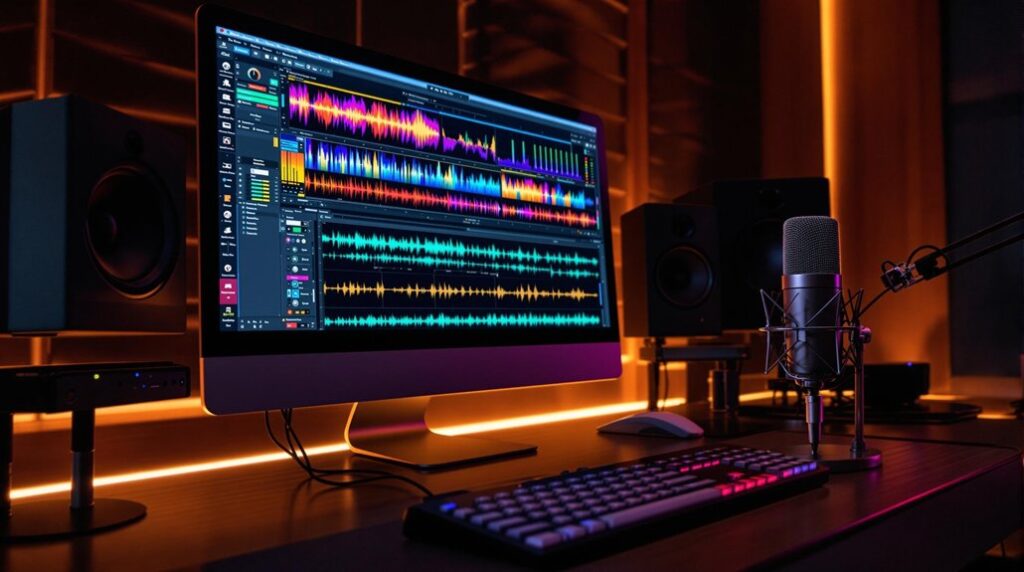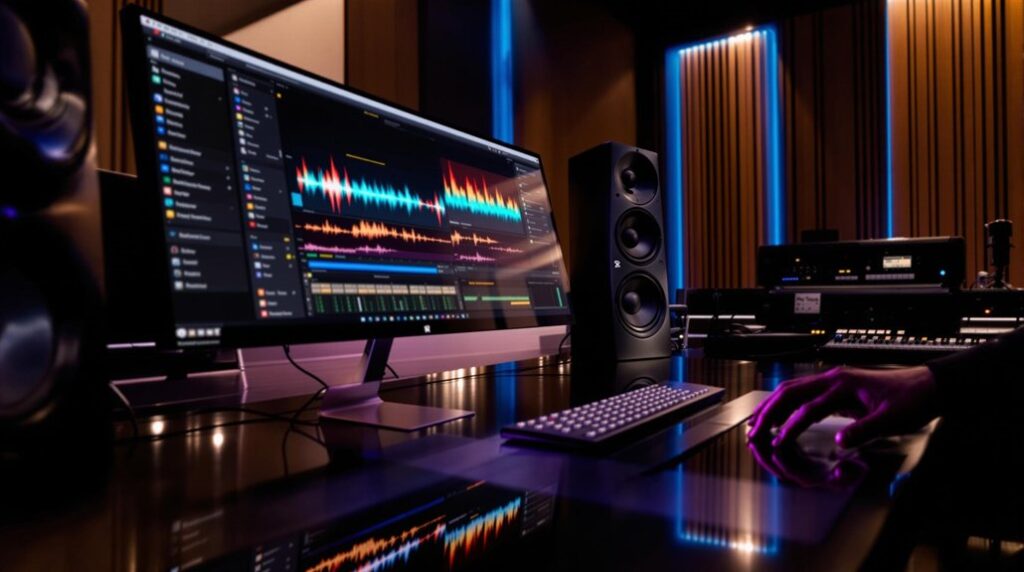In digital audio production, the rivalry between Pro Tools and Logic Pro highlights five significant differences. Pro Tools operates on a subscription basis with multiple tiers, whereas Logic Pro requires a single purchase. Pro Tools' dual-platform compatibility contrasts with Logic Pro's exclusive macOS operability. The learning curve is steeper in Pro Tools, demanding technical expertise, while Logic Pro offers an intuitive interface. Pro Tools excels with robust recording and mixing features, supporting advanced post-production capabilities. In contrast, Logic Pro boasts an extensive virtual instrument library. Understanding these differences enhances decision-making for your audio production journey.
Key Takeaways
- Pro Tools supports both macOS and Windows, while Logic Pro is exclusive to macOS, affecting user accessibility.
- Logic Pro is a one-time purchase at $199, compared to Pro Tools' annual subscription tiers.
- Pro Tools offers advanced post-production features and precise automation for detailed mixing.
- Logic Pro provides an intuitive interface, allowing quicker skill acquisition compared to Pro Tools' steeper learning curve.
- Logic Pro includes over 100 virtual instruments, whereas Pro Tools focuses on high-quality stock effects.
Payment Models and Accessibility
While traversing the terrain of digital audio workstations (DAWs), understanding the payment models and accessibility options is essential for selecting a platform that aligns with both creative and budgetary needs.
Pro Tools operates on a subscription-based model, offering tiers like Pro Tools Artist ($99/year), Studio ($299/year), and Flex ($999/year) for varied user requirements. This model, despite offering a free trial, may incur higher long-term costs.
Conversely, Logic Pro is a one-time purchase at $199, offering a cost-effective choice with free updates, appealing to budget-conscious users.
Pro Tools supports both Mac OS and Windows, enhancing accessibility, whereas Logic Pro's exclusivity to macOS limits its user base.
Therefore, financial and platform considerations are pivotal in this DAW selection process.
System Compatibility
System compatibility stands as a crucial factor when evaluating digital audio workstations (DAWs) for professional environments.
Pro Tools, developed by Avid Technology, offers robust compatibility with both macOS and Windows systems, ensuring flexibility and adaptability across diverse studio environments. This cross-platform functionality allows seamless integration with a wide range of audio interfaces and hardware configurations, enhancing Pro Tools' appeal in various professional settings. Many audio interfaces like the Focusrite Scarlett 2i2 4th Gen offer exceptional preamps and are highly compatible with Pro Tools, making them a popular choice among users.
In contrast, Logic Pro, a product of Apple's acquisition, operates exclusively on macOS. This limitation confines its use to Apple device users but simultaneously benefits from unparalleled software integration within the Apple ecosystem.
Logic Pro's seamless compatibility with other Apple applications and devices streamlines the workflow, offering macOS users an optimized audio production experience tailored to their specific needs.
Learning Curve Differences
Maneuvering the learning curve of digital audio workstations (DAWs) requires an understanding of their inherent complexity and usability. Pro Tools presents a steeper learning curve, largely due to its intricate interface and reliance on advanced audio editing terminology. This can be intimidating for users new to music production, demanding significant technical knowledge of digital signal processing and session management. Pro Tools users may benefit from custom keyboard shortcuts to optimize their workflow efficiency and reduce reliance on default settings, making the software more approachable. Conversely, Logic offers a more intuitive interface, enabling users to engage quickly in creative processes without extensive technical prerequisites. The keyboard shortcuts in Pro Tools are essential for efficient operation, whereas Logic's shortcuts enhance user accessibility and creativity. While mastery of both DAWs demands practice, Logic's design facilitates a swifter acquisition of skills, contrasting Pro Tools' more gradual proficiency journey.
Recording and Mixing Features
Understanding the learning curve of DAWs naturally leads to examining their recording and mixing features, which greatly impact user experience and project outcomes.
- Pro Tools Audio Recording: Known for its superior audio recording capabilities, Pro Tools supports up to 256 mono tracks, facilitating complex sessions and extensive mixing.
- Logic Pro Track Arming: While Logic Pro's recording process is robust, it lacks the extensive track arming options of Pro Tools, which can streamline larger productions.
- Post-Production and Audio Editing: Pro Tools excels in post-production with advanced syncing and audio editing features tailored for film and television.
- Automation Capabilities: Both DAWs offer automation, yet Pro Tools stands out for its precise automation, essential for detailed mixing in professional settings.
For optimal audio recording in Pro Tools, it is crucial to configure I/O settings accurately to ensure the correct input paths and prevent digital clipping during recordings. Evaluating these features can guide users in choosing the right DAW for their needs.
Stock Effects and Instruments
Exploring the field of stock effects and instruments in digital audio workstations (DAWs) reveals significant divergences between Pro Tools and Logic Pro, each catering to different production needs.
Pro Tools excels with high-quality stock effects including reverbs, delays, and compressors, yet its selection of virtual instruments pales compared to Logic Pro.
Logic Pro, renowned for its robust audio production capabilities, provides over 100 virtual instruments and an expansive sound library, appealing to diverse musical genres.
Plugin compatibility also varies; Pro Tools utilizes the Avid Audio Extension (AAX) format, while Logic Pro adopts Audio Units (AU), impacting integration with third-party plugins.
Importantly, Logic Pro's advanced MIDI composition tools, like arpeggiators and chord triggers, offer music producers enhanced creative possibilities over Pro Tools.
In addition, Pro Tools' AAX DSP plugins offer near-zero latency performance, making it ideal for professional recording sessions where timing precision is crucial.
Frequently Asked Questions
What Is the Difference Between Logic and Pro Tools?
Logic features advanced MIDI capabilities and a user-friendly interface, enhancing workflow efficiency for music production. Pro Tools excels in audio editing with robust collaboration tools. Price comparison reveals Logic's one-time purchase is more economical. Plugin support varies.
What Can Pro Tools Do That Logic Cannot?
Pro Tools surpasses Logic in audio editing precision, session management capabilities, and video integration, offering robust collaboration features and extensive plugin support. Its superior mixing tools, track count, and automation options cater to high-demand professional environments, mitigating compatibility issues.
What Are the Disadvantages of Logic Pro?
Logic Pro's limitations include a complex user interface, restricted plugin compatibility, and suboptimal audio editing capabilities. Its steep learning curve, macOS-exclusive system requirements, and one-time pricing structure may deter users seeking extensive support and advanced MIDI features.
Do Professional Musicians Use Logic?
Yes, professional musicians frequently use Logic Pro due to its robust music production capabilities, user-friendly interface, extensive MIDI support, and advanced audio editing features. Its plugin support and budget-friendly pricing enhance workflow efficiency across diverse genres.
Conclusion
To sum up, the comparison between Pro Tools and Logic Pro reveals key distinctions in payment models, system compatibility, learning curve, recording and mixing features, and stock effects and instruments. Pro Tools often appeals to industry professionals due to its robust recording and mixing capabilities and subscription-based model. Logic Pro, with its user-friendly interface and extensive suite of stock instruments and effects, is favored by those seeking an all-in-one solution for music production. These differences cater to varying needs within audio production workflows.




